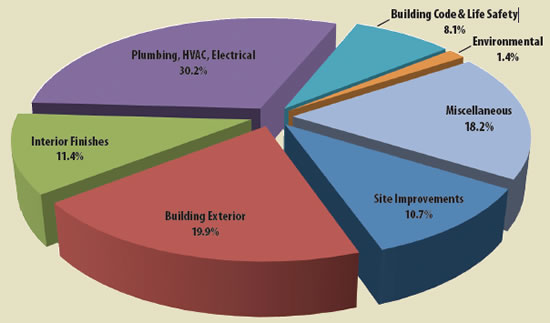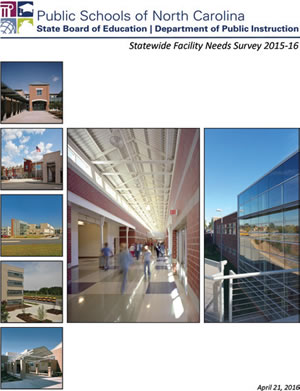Kicking the Can Down the Road

IMAGES COURTESY OF SCHOOL PLANNING SECTION OF NC DPI
Breakdown of deferred maintenance costs statewide in N.C.
There is no better source of information regarding the overall
condition of school buildings than
with the school district’s maintenance
department. The challenge is gathering the
information efficiently and developing consistent
reports to support funding requests.
A year ago, school districts in North
Carolina received directives to fill out the
2015-16 Facility Needs Survey, which is
required by state law every five years. The
report is used by state and local government
to monitor and track funding requirements
for public school facilities. Construction and
renovation needs for North Carolina schools
totaled $8.1 billion dollars over a five-year
time horizon. Several states have similar
programs compelling local school officials
to identify their maintenance backlog and
assign prioritized cost estimates. Dr. Ken
Phelps, with North Carolina’s school planning
section says, “The need to keep track of
deferred maintenance is significant in many
of our school districts. It is our hope that the
facility needs report provides a structure
which districts can utilize each year to support
requests for funding.”
The need for major repairs to school
buildings must be justified and well documented
to have the best chance of receiving
necessary levels of approval. When information
is consistently accurate, current and
accessible to funding authorities, available
resources stand a better chance. When
the opposite occurs, a level of distrust and
confusion often results in the withholding of
critical resources. This forces deferred maintenance
to increase, sometimes exponentially.
School officials find themselves in a “run
to fail” mode, having to request emergency
funding to make immediate repairs.
School districts that begin their fiscal
year in July, start the budget preparation
cycle in the early Spring. Facilities and maintenance
managers are often advised to begin
their budgeting process much sooner in order
to adequately assess facility needs. There
are many different classifications of capital
costs that must be anticipated, including
construction dollars for opening new schools
or additions, resources for implementing
new programs or initiatives, and the cost of
maintaining existing facilities.
Districts routinely use consultants to conduct facility condition assessments
which provide very detailed information,
particularly in the area of deferred
maintenance. Depending on the district’s
circumstances, this may be necessary;
however, it can be very expensive and time
consuming. For considerably less time and
expense, consideration should be given to
collecting data by conducting interviews
with key stakeholders. A key advantage
to this method is that it can be performed
from a central location and the process can
easily be repeated on an annual basis. The
following method for developing a deferred
maintenance plan can easily be modified to
meet the specific needs of the organization.
 Data organization
Data organization
Each deferred maintained item should be
indexed by type of building system and by level
of priority. The North Carolina survey organizes
building systems into nine basic categories
which work well for this level of reporting.
Consider the following basic categories:
- Site
- Building Interior
- Building Exterior
- HVAC, Electrical, Plumbing
- Furniture and Equipment
- Environmental
- Building Code/Life Safety
- Food Service
- Technology
Once the total costs of the district’s deferred
maintenance is known, there will be a
need to make adjustments in terms of priority.
Using a simple priority structure will help to
determine reasonable budget requests while
showing the total amount of backlog. Having
the items previously identified will shorten the
process when the plan is updated each year.
Priorities can be organized as follows:
- Priority A - Immediate
- Priority B - Years 1-2
- Priority C - Years 3-5
Data collection
Develop an interview schedule for key
personnel in the district holding firsthand
knowledge of specific building systems.
Depending on the size of the district, this
can range from three to five people to as
many as 15 to 20 people in districts with
more schools. Starting with the list of building
system categories, facility administrators
can help identify key personnel to be
interviewed. The interview session should
be facilitated by a person having broad
knowledge and experience with educational
facilities. It is important to have a second
person to record the data obtained during
the interview. It is helpful for everyone to see
the data while it is being collected. A spreadsheet
template projected on a large screen
works very well for this purpose. Do not forget to include non-instructional facilities,
i.e. administrative offices, maintenance and
transportation facilities, etc.
It is helpful for the person to be interviewed
to bring along any notes, lists,
inventories they may have concerning their
particular building system. As the facilitator
moves from one facility to the next, it
should be determined quickly if there are
any deferred maintenance issues worth
noting for the particular building system.
If none exist, move on to the next location.
If there is an issue, it should be identified
with a leading action verb. Most often the
operative word will begin with “re…” (i.e.
replace, restore, repair, renovate, etc.) The
general location of the maintenance issue
within the facility should be noted. Each
item should also be assigned a prioritization
category based upon the timeframe in
which it needs to be accomplished.
Cost estimating
It is not necessary to have actual proposals
or detailed project estimates prepared by contractors.
At this level of planning, reasonable
cost estimates based on the related experience
of the people in the room are sufficient. There
is a significant difference in the development
of a deferred maintenance plan and a project
plan. Generally speaking, it is unnecessary to
determine specific locations, quantities, product
types for this level of planning. We simply
need to know of the existence of a deferred
maintenance item in a particular facility, a
level of prioritization, and an approximate
cost. Additional, supporting information may
be helpful, but it may also overload and delay
the reporting process. As the cost estimating
process unfolds with each person being
interviewed, the review technique becomes
routine, cost standards begin to emerge, and a
general pattern of needs comes to light.
The key to providing consistent, accurate,
and current information related to deferred
maintenance is to develop and implement a
standardized process. Allowing the maintenance
staff to participate in the development
of the annual deferred maintenance plan can
yield benefits beyond the collection of data.
In organizations concentrating on
increasing effectiveness in the classroom,
deferred maintenance tends to become the
forgotten stepchild. Strong documentation
of actual needs (complemented by constituent
testimony) can be the key to funding
now rather than paying more later.
This article originally appeared in the issue of .